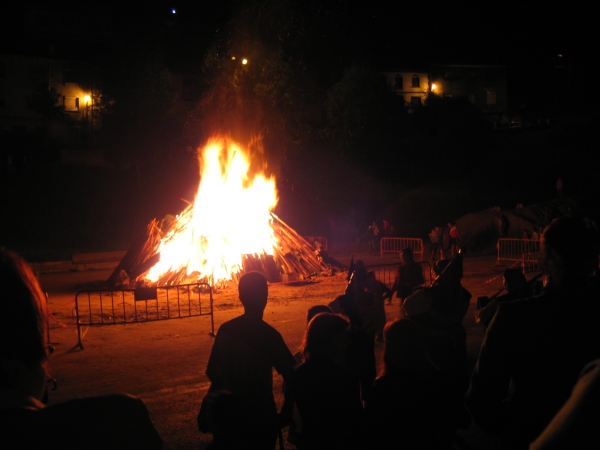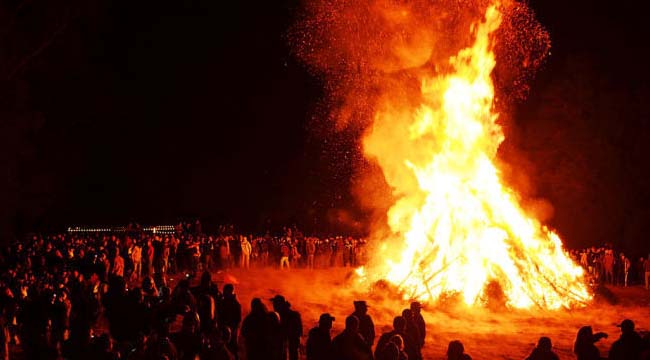La Noche de San Juan – long version
The Night of San Juan
- Remember, expect this to be challenging.
- First, read the English version.
- Next, read the Spanish version.
- Click the control to hear the audio.
- Listen several times, following along on the transcript.
- Finally, listen without looking at the transcript.
- See how many words and phrases you can pick out.
- Read and answer the comprehension questions.
- Visit the links if you like!
- We recommend you do the short version first.
Long Version
The Night of San Juan
The night is cool and the fine rain covers the narrow streets of this town among the mountains of the Spanish region
of Asturias. ¨This is San Juan´s weather!¨ the elderly say
and meanwhile the younger ones get excited with the idea of
staying awake until late hours of the night. It is fifteen minutes to midnight and under their umbrellas families walk
down the streets heading to the main plaza of the town, to witness the yearly Bonfire of San Juan (¨Hoguera de San Juan¨).
Behind the crowd, on the front of the plaza, one can see the groups of folk music musicians, with their pipes and drums,
beginning to celebrate as midnight approaches. The fireworks decorate the summer sky, and underneath them the residents
of town celebrate the arrival of summer solstice. Midnight arrives and with it the bonfire flames illuminate the surrounding
plaza and the hundreds of faces that watch as the improvised pile of old furniture and wood vanishes under the flames. Its
a magical night for the younger ones, a tradition for the elders, and a night of celebration and purification for everyone.
In the northwest region of Spain, Asturias, as it happens in many other areas of the country, The Night of San Juan is
celebrated in every town and city to welcome the summer solstice. It is believed that the power of the fire can purify, and
those present can benefit from the proximity to the bonfire; getting rid of the misfortunes of the past year and entering a new
season free from burden.
The youth of the town are those who for days and even weeks before The Night of San Juan would gather in their free hours, old
furniture and woods that the neighbors donate to build the bonfire. The youth work piling all of their found goods in the middle
of the plaza and they take pride in the large and impressive result. It is also tradition to set a ¨muyerona¨, or doll made out
of old fabrics on the top of the main pole that supports the bonfire. This doll, or woman, represents the misfortunes that happened
throughout the year and which must be burned in order to be purified.
Being a witness of the Bonfire of San Juan is a magical experience. It will purify and illuminate you, giving you a vision of
the ancestral traditions of this country.
La Noche de San Juan
La noche es fresca y la lluvia fina cubre las callejuelas de este pueblo entre montañas de la región española de Asturias.
¡ Tiempo de San Juan!¨ se oye decir a los abuelos… y mientras, los más jóvenes de la familia se llenan de excitación ante la idea
de quedarse levantados hasta altas horas de la noche. Faltan quince minutos para la medianoche y bajo los paraguas familias al completo
desfilan calle abajo en dirección a la plaza del pueblo para ser testigos, un año más, de la Hoguera de San Juan, o ¨Foguera de San
Xuán¨ (en asturiano). Tras el gentío, allá al frente de la plaza, se divisan ya los grupos de música folclórica que acompañados de sus
gaitas y tambores comienzan a celebrar la proximidad de la medianoche. Los fuegos artificiales engalanan el cielo de la noche veraniega,
y bajo éstos los residentes del pueblo festejan la llegada del solsticio de verano. La medianoche llega y con ella la hoguera se prende
en llamas que resplandecen en los alrededores de la plaza del pueblo, iluminando los cientos de rostros que perplejos observan como la
improvisada pila de muebles viejos y madera se desvanece ante el fuego. Es una noche mágica para los pequeños, de tradición para los
mayores, y de celebración y purificación para todos ellos.
En la región del noroeste de España, Asturias, como en muchas otras partes del país, la Noche de San Juan es celebrada en cada pueblo
y ciudad como recibimiento del solsticio de verano. Se cree que el poder del fuego sirve como purificación y aquellos presentes se
benefician de la proximidad a la hoguera deshaciéndose así de los males del año y entrando en una nueva estación limpios y libres de éstos.
Los jóvenes del pueblo suelen ser quienes días o incluso semanas antes de la Noche de San Juan, en horas perdidas, hacen acopio de todos
los trastos viejos, muebles, maderas sin uso que los vecinos van donando para formar la hoguera. Los chicos trabajan apilando todo lo
encontrado en el centro de la plaza del pueblo y se enorgullecen del tamaño de la hoguera y la cuidada forma que le dan. Es tradición
también poner la ¨muyerona¨ o muñeca hecha de telas viejas y harapos, en lo alto del palo central que sujeta la hoguera. Esta mujer
representa el cúmulo de males que han ocurrido durante el año y a los cuales se les debe de quemar para purificarse.
Ser testigo de la quema de la hoguera de San Juan es toda una experiencia mágica que si no te libera de males, bien te ilumina y da visión
del poder de las tradiciones ancestrales del país.
Comprensión
- ¿Dónde es tradición celebrar esta fecha?
- ¿Quiénes asisten a este acontecimiento?
- ¿Qué se celebra en esta noche?
- ¿Qué es “la hoguera”?



